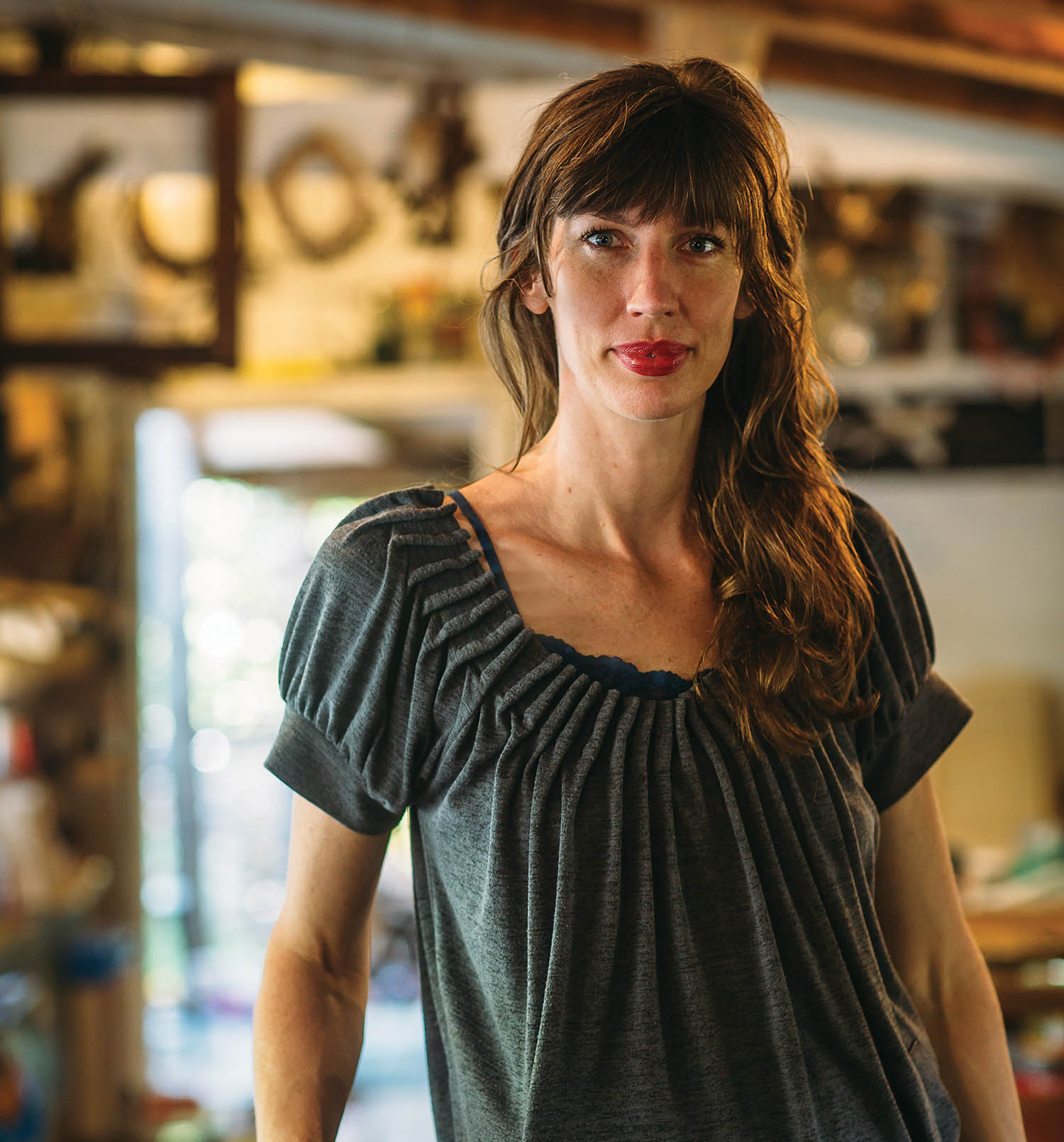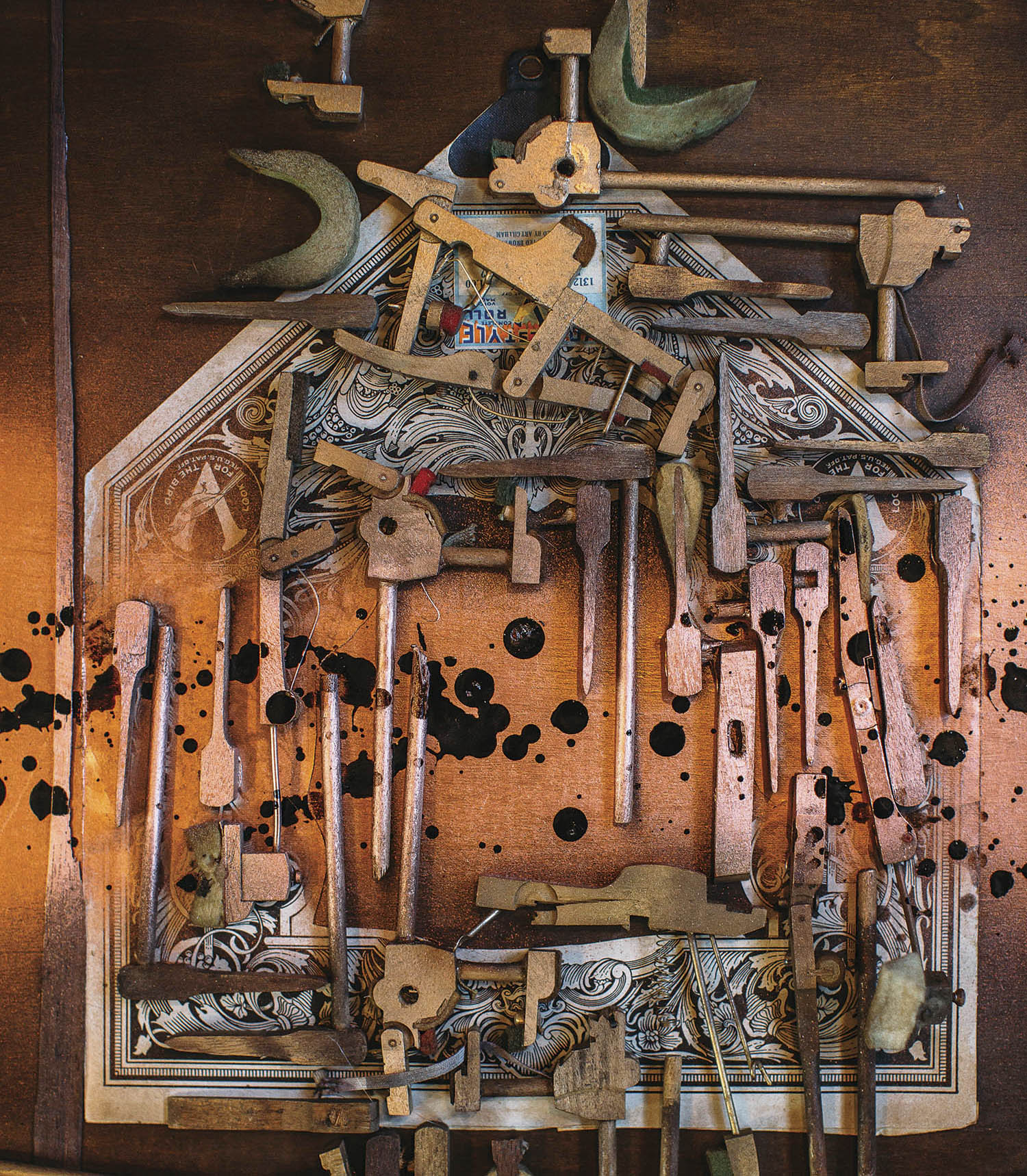
Kehren Barbour accepts unwanted pianos, lets them disintegrate, then transforms them into new instruments. Photo by Tim Robison
Tucked into Kehren Barbour’s purse is a small card with a photo of early motion-picture actor George Murphy. It reads: “Your sunny attitude towards life is a constant inspiration to your friends.”
It’s something like a weird fortune cookie, but Barbour, an Asheville artist, didn’t acquire it from a fried-rice takeout order. It’s one of several items she’s come across since she and her husband, Michael Luchtan, started deconstructing pianos as part of their Post Piano Project. The part-auditory, part-visual endeavor begin in 2012 and is mostly worked on through the duo’s produce-stand-turned-art-studio in Gerton.
“Each of the pianos is its own time capsule with these messages in them, and sometimes there are literal messages,” says Barbour, who has found other pieces of paper and notes from tuners inside pianos.
Almost 40 pianos are now a part of the project, begun for a couple of reasons: Luchtan decided to teach himself to play, and after the couple befriended a local tuner, Barbour became interested in the materials used to make and maintain the instrument.
Donated to the project by community supporters and businesses, the pianos, broken down and resurrected, are now sound installations and sculptures of greatly varying size and mood. Strings and keys are isolated, re-crafted, and highlighted in fresh arrangements. Barbour finds a way to utilize each salvaged scrap.

The artist’s smaller assemblage pieces are meant to be displayed, not played. Photo by Tim Robison
“We can build other instruments from these,” she told her husband when the idea struck, “and we could build other pieces with these, and there’s a whole category of conversations that can be had about use and reuse.”
Barbour once shared a studio in Asheville’s River Arts District, but the upstairs work space couldn’t accommodate the Post Piano Project (taken together, those 88 keys can be a bear to push up a set of stairs). They looked online and finally found a suitable space, a structure that’s stood on the Stone and Lyda families’ homesteads for generations. Now they produce art in the old produce stand.
The barn-red workshop, which Barbour calls the Aeolian Harp Research Station, sits off Highway 74 in Henderson County between Asheville and Lake Lure. Pianos reside outside and are battered, on purpose, by the four seasons. Barbour learned that exposing the wooden instruments, some of them more than 100 years old, to the elements is the simplest way to break them down. “They are very sturdily built,” she says. “We fight the ideas of decay, but as things decay they reveal the process and the materials and things get a lot easier.”
Before the rot begins, though, Luchtan writes one last piece to be played on the selected instrument, and the couple records the requiem before building new from old. “It lets me put the instrument to rest before I start to take [it] apart and its inner workings become revealed,” explains Barbour.
She has described her musical inventions — mostly crafted from the guts of the disassembled pianos, including the interior harps and soundboards — as “wind harps” (similar to the ancient Aeolian harp or lyre) or “authorless instruments.” They can be played by a person, a breeze, or, in one instance, pigeons.
The artist calls the body of her smaller works “Souvenirs,” and the individual collage assemblages are styled “Tone Poems,” after the work of early modernist composer Richard Strauss.
“When I’m making the art pieces, I think of the mood of the piano,” Barbour says. “Was it a honky-tonk piano or a classical piano? Was this a jazz piano? I try to emulate the sound in the art.
“I also think about all the hands and all the players,” she adds. “You have the skilled craftsmen in the factories. The piano tuners. The players who could be anyone from our great grandmothers to any one of our children. You have these intergenerational interactions with this instrument that I hope to pull the sound out of … before I literally pull the sound out of it.”
The Aeolian Harp Research Station is located at 4413 Gerton Hwy. For more information about the Post Piano Project and a list of regional galleries that show Kehren Barbour’s work, see kehrenbarbour.com.
